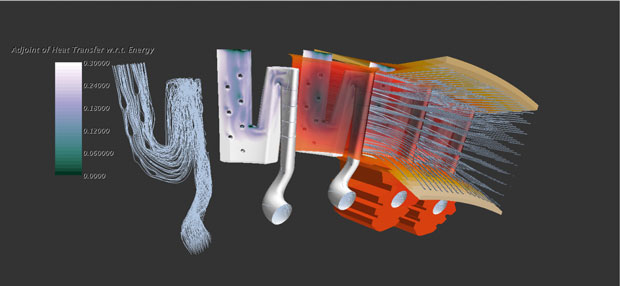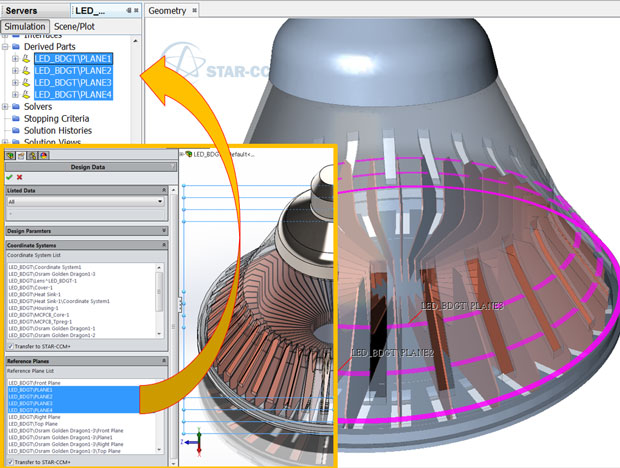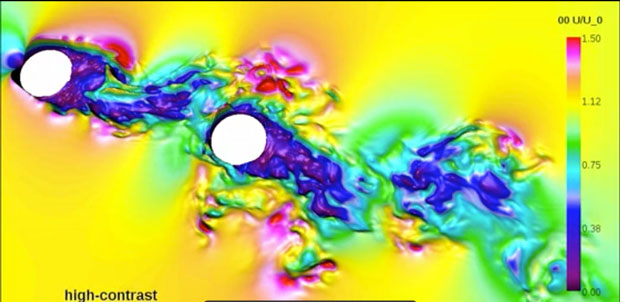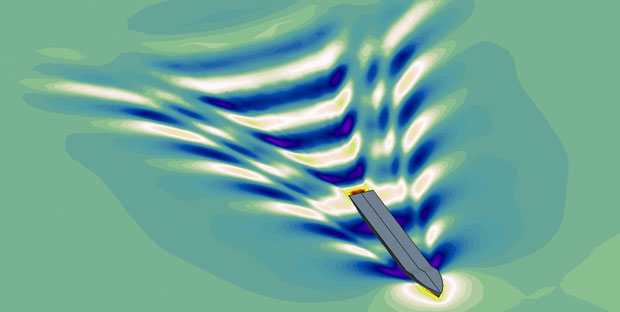
STAR-CCM+ v10.04 debuts a new Adjoint Solver for Coupled Solid Energy that enables sensitivity analysis of solid conduction problems. This screen shows a scalar plot of magnitude of adjoint heat transfer with respect to energy on the internal surface of a cooled turbine blade. Image courtesy of CD-adapco.
Latest News
July 8, 2015
CD-adapco has announced version 10.04 of STAR-CCM+, the second release in 2015 of its flagship simulation system for solving problems involving the flow of fluids and solids, heat transfer and stress. The highlight of the v10.04 release, says the company, is an entirely new finite element-based Solid Stress Solver enabling computational solid mechanics within STAR-CCM+. This addition, adds the company, makes STAR-CCM+ the first tool on the market to offer both computational fluid dynamics (CFD) and computational solid mechanics in a single, fully integrated environment.
The new computational solid mechanics functionality integrates with STAR-CCM+’s fluid analysis tools and uses the same interface, eliminating the need for separate applications. With the addition of computational solid mechanics functionality integrated with fluid dynamics in a single environment, STAR-CCM+ now offers an efficient way for modeling FSI (fluid-structure interaction) problems such as the flexing of an airliner’s wings as air flows around it.
“The introduction of computational solid mechanics in STAR-CCM+ is a very important step in terms of the future direction of engineering simulation,” said Jean-Claude Ercolanelli, senior vice president of Product Management, CD-adapco, in the version 10.04 press announcement. “Engineers can now easily bridge the gap between the fluid and structure disciplines within one single user interface and environment. Previously, this was only possible using multiple tools and different skill sets across several teams. STAR-CCM+ users are now able to expand their applications scope and be effective immediately. The new Computational Solid Mechanics capability [uses] the same interface and does not require an additional license.”
In addition to the introduction of the new finite element-based Solid Stress Solver in STAR-CCM+, v10.04 sees the implementation of an Adjoint Solver for Coupled Solid Energy, improvements to geometry transfers, features for report generation and new color maps.
 STAR-CCM+ v10.04 debuts a new Adjoint Solver for Coupled Solid Energy that enables sensitivity analysis of solid conduction problems. This screen shows a scalar plot of magnitude of adjoint heat transfer with respect to energy on the internal surface of a cooled turbine blade. Image courtesy of CD-adapco.
STAR-CCM+ v10.04 debuts a new Adjoint Solver for Coupled Solid Energy that enables sensitivity analysis of solid conduction problems. This screen shows a scalar plot of magnitude of adjoint heat transfer with respect to energy on the internal surface of a cooled turbine blade. Image courtesy of CD-adapco.The Adjoint Solver for Coupled Solid Energy enables sensitivity analysis of solid conduction problems. With the Coupled Solid Energy solver, engineers can use a heat transfer cost function to obtain information about how a design’s thermal behavior will be affected by changes in geometry and boundary conditions as well as different mesh structures. The Adjoint Solver for Coupled Solid Energy can be used on fluids or solids in isolation or in conjunction with the Adjoint Flow Solver to perform sensitivity analysis and optimization of problems involving conjugate heat transfer.
 Beginning with version 10.04, users can now pass more data from their CAD package to STAR-CCM+. This image shows the importation of reference planes and coordinate systems. Image courtesy of CD-adapco.
Beginning with version 10.04, users can now pass more data from their CAD package to STAR-CCM+. This image shows the importation of reference planes and coordinate systems. Image courtesy of CD-adapco.With v10.04, users can now pass more data from their CAD package to STAR-CCM+ through their STAR-CAD clients. This capability includes passing such data as transfer coordinate systems and reference planes, which are synchronized during updates automatically. This functionality, says CD-adapco, also allows for easy boundary condition creation and post-processing based on CAD references.
Improvements to Custom Summary Reports functionality introduced in v10.04 are said to help users create well-formatted, customized summaries of specific objects within a simulation. With these summaries, engineers can review simulation file content without opening the file. The functionality also simplifies comparing results from different simulations, according to the company.
 STAR-CCM+ v10.04 delivers 22 new ready-to-use color maps. CD-adapco says that these new color maps can be grouped into four categories: High-Impact, Perceptual, Diverging and Specialty. This screen captured from a slide show illustrates an image characterized as high-impact with high-contrast. Image courtesy of CD-adapco.
STAR-CCM+ v10.04 delivers 22 new ready-to-use color maps. CD-adapco says that these new color maps can be grouped into four categories: High-Impact, Perceptual, Diverging and Specialty. This screen captured from a slide show illustrates an image characterized as high-impact with high-contrast. Image courtesy of CD-adapco.STAR-CCM+ v10.04 delivers 22 new color maps, which should help streamline the visualization workflow and help users gain a better understanding of their simulation results through high-impact scientific visualization. Other new features introduced in v10.04 include a capability for exporting boundary data and a new DFBI (dynamic fluid body interaction) motion type for sink and trim calculations in the marine industry.
CD-adapco says that the new Boundary Data Export for Simulation History functionality reduces the size of the simulation history files and, it adds, increases the overall performance by delivering the ability to save results for boundaries only. The company describes the new Equilibrium DFBI motion type as suitable for scenarios where a force and moment balance can ultimately exist in equilibrium. This new functionality “drastically” reduces computational expenses when compared to a time-accurate unsteady free-motion simulation, according to the company.
 A new DFBI (dynamic fluid body interaction) motion type for sink and trim calculations in the marine industry is part of STAR-CCM+ beginning with version 10.04. This screen image shows a typical Kelvin wave pattern around a vessel in a sink and trim simulation. Image courtesy of CD-adapco.
A new DFBI (dynamic fluid body interaction) motion type for sink and trim calculations in the marine industry is part of STAR-CCM+ beginning with version 10.04. This screen image shows a typical Kelvin wave pattern around a vessel in a sink and trim simulation. Image courtesy of CD-adapco.Miscellaneous enhancements in v10.04 of STAR-CCM+ include a new tab in the Optimate design exploration and optimization toolset interface that gives users live updates of simulation progress during the design, which can facilitate troubleshooting.
CD-adapco reports that many of the new features STAR-CCM+ v10.04 incorporates were drawn from suggestions submitted by users. For more information about STAR-CCM+, visit CD-adapco.
Click here to learn about Computational Solid Mechanics in STAR-CCM+ v10.04.
Learn more about the new Adjoint Solver for Coupled Solid Energy here.
Learn more about the new geometry transfer capabilities in STAR-CCM+ v10.04 here.
See why DE‘s editors selected STAR-CCM+ v10.04 as their Pick of the Week.
Sources: Press materials received from the company and additional information gleaned from the company’s website.
Subscribe to our FREE magazine, FREE email newsletters or both!
Latest News
About the Author
Anthony J. Lockwood is Digital Engineering’s founding editor. He is now retired. Contact him via [email protected].
Follow DERelated Topics






